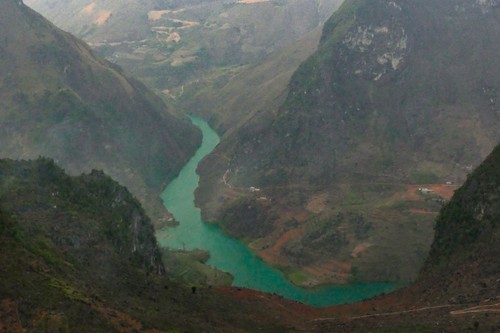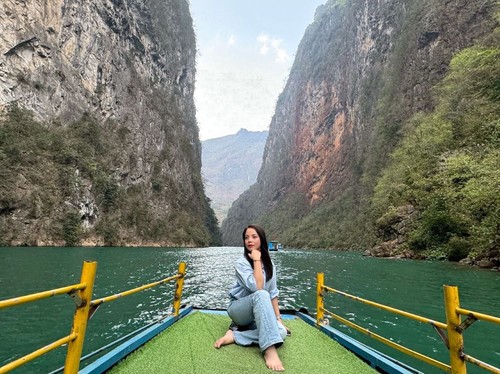 Nho Que is one of the most beautiful rivers in Ha Giang province. (photo: Vinh Phong) Nho Que is one of the most beautiful rivers in Ha Giang province. (photo: Vinh Phong) |
The Nho Que river starts in the Yanshan mountains in China’s Yunnan province and flows for 200 km, the last 50 km in Vietnam’s Ha Giang province. The river enters Vietnam in Lũng Cú commune, Đồng Văn district, and passes through Tu Sản canyon to Meo Vac district, then bends through the Ma Pi Leng pass where it attracts many tourists.
From above the Ma Pi Leng pass, the Nho Que river looks like a shimmering turquoise thread hanging down from the sky against the mountains and forests. Although surrounded by rugged mountains, the Nho Que river seems very calm and peaceful.
Pham Duy Nhuan, a tourist from Ninh Binh province, said: “I contemplate the river from above and its turquoise color is much more beautiful than I could imagine. When I go down to the river, I’m thrilled by its beauty and majesty. The sunlight shining through the ravine onto the river is a picturesque sight.”
Local people have a legend about how the Nho Que river was formed. Once upon a time, the river flowed only on one side of the mountain. On the other side there was no river. The land there was dry and the grass and trees withered. One day, the River Genie asked the Mountain Genie to move aside so that the water could flow to the dry land, but the Mountain Genie pretended not to hear. The River Genie reported this to the Jade Emperor.
One rainy night an explosion shook the heaven and earth and the mountain broke in two. The water began flowing to both sides. Wherever the water reached, the trees and plants grew lush. The water became the Nho Que river, which flows through the Ma Pi Leng pass in the Sam Pun mountain range. After bends and rocky rapids, the river becomes gentler as it flows through Meo Vac district, where boats can travel gently.
 A boat tour on the river is an unforgettable experience. (photo: Vinh Phong) A boat tour on the river is an unforgettable experience. (photo: Vinh Phong) |
The boat takes tourists down the wide-open turquoise river, through majestic mountains via Tu San canyon, the most majestic canyon in Southeast Asia, where there are cliffs 700-800 meters high.
Vang Mi Sa, a local boatman, said: “I’ve been a boatman for six years. Every day I make two or three trips. We take tourists along the river, stopping at Tu San canyon for photos. Foreign visitors really love coming here.”
Some tourists shared their feelings. “This is the 5th time I’ve visited Ha Giang, but it’s the first time I’ve traveled on the Nho Que river. I learned about boat tours on the river from tourism forums. Today the weather is as wonderful as autumn in Hanoi. The river water is turquoise and there are red-silk cotton flowers dotting the mountains. It’s wonderful.”
“This is the first time I’ve visited Ha Giang. I was overwhelmed by the majestic scenery. The most impressive thing is the Nho Que river, the tranquil water surrounded by mountains and forests. It’s very peaceful, charming, and poetic. If I have another chance to come to the northwest region, I’ll choose Ha Giang again.”
“My friends told me that Ha Giang is beautiful. But the far distance made me hesitate. Finally, I came here in the spring and I was overwhelmed. It made me forget about time and I don’t want to leave this romantic place.”
The Nho Que river is the source of life for living things on both banks. Visitors can go kayaking on the calm river, relax at a homestay or restaurant at the foot of the mountains, and enjoy the delicious local dishes.